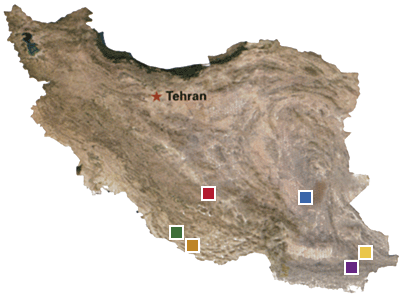A country with an extraordinary historical and archaeological legacy, Iran has recently reopened its borders to foreign scholars ("Iran Beckons," May/June 2004). Right now, some parts of the country need all the archaeologists they can get--dam projects in the vicinity of Pasargadae, first capital of the Persian Empire, and along the Karun River in southwestern Iran will soon submerge countless known and unknown sites ranging from the Neolithic to Medieval periods.

 | Espidej: A whetstone, brass ladle, and awl were among the tools buried with a metalworker more than 3,000 years ago in a necropolis in Sistan-Baluchistan. A brass figurine of a dog less than half an inch long was also recovered during the excavation of the tomb. |
![[image]](thumbnails/iran1.gif)
![[image]](thumbnails/iran2.gif)
(Madjidzadeh/Iranian Cultural Ministry/Gamma) Click images for larger versions. |
 | Jiroft: More than 100 artifacts from the 5,000-year-old site, plundered by looters for the past several years, will go on display in Tehran after being confiscated by British customs last summer and returned to Iran in January. |
 | Charkhab: Three of the four ornate column bases that graced the entrance to a palace belonging to Cyrus the Great (r. ca. 559-529 B.C.) have been discovered during excavation work in the southwestern coastal province of Bushehr. Archaeologists likened the elaborate bases to similar ones at Cyrus' capital at Pasargadae. |
 | Tang-e Bolaghi: A village recently discovered only two miles from Pasargadae is providing archaeologists with a unique look at the lives of ordinary people living in the Persian era. Scholars estimate it will take four years to properly excavate the village, but the dam that will flood the area will be completed next year. |
 | Bam: The discovery of early skeletons found inside the walls of the mud-brick citadel, revealed in the aftermath of the earthquake that destroyed much of the ancient city, had puzzled scholars. New studies suggest the 62 sets of remains, all belonging to young children or infants, were buried when Bam was besieged in the nineteenth century. Since young children are not subject to Islamic law regarding burial in the earth, those who died duried the siege were simply interred in the city's walls. |
 | Dashtestan: A fragmentary sculpture featuring the head of Darius the Great (r. 522-486 B.C.) and a servant carrying an umbrella behind him has been discovered at the Persian king's palace in Bushehr Province. An inscription was also recovered, and is being translated. |

© 2005 by the Archaeological Institute of America
archive.archaeology.org/0505/newsbriefs/iran.html |







![[image]](thumbnails/iran1.gif)
![[image]](thumbnails/iran2.gif)



